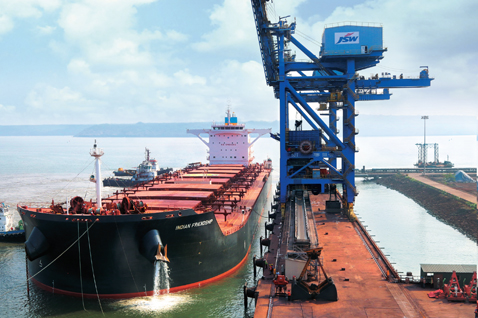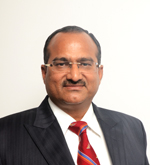
 —Capt B.V.J.K. Sharma, Joint Managing Director & CEO, JSW Infrastructure
—Capt B.V.J.K. Sharma, Joint Managing Director & CEO, JSW Infrastructure
Discuss the synergy that JSW Infrastructure derives from group cargo.
The port business is very capital-intensive; you will have to have a master plan that takes a five-, ten-, fifteen- or even a 50-year perspective. You can develop ports only in phases. And there are necessary elements like dredging and breakwater that are capital intensive. So one has to plan port projects in a manner that “Phase 1” is sustainable. That is where we have the highest synergy, because in Phase-1, we get the group cargo support. With financial closure done, rolling out other phases becomes easier. In other phases, we offer services to outside parties, and we keep developing more phases. We have adopted this model pan-India.
Give us an idea of your cargo volumes.
We started developing the Goa terminal in 2003. Goa started operating its first ship in 2014 and since then, Goa has handled 60 million tonnes. Now, we handle 10 million tonnes annually. We got complete environmental clearance for Jaigarh in 2007. The port handled its first cargo ship in 2009. Now, we have deepened the port from 7m to 20m, offering service to capesize vessels. This year we are targeting 8.5 million tonnes. We have plans to take Jaigarh port’s capacity from the present 15 million tonnes to almost 85 million tonnes.
What is the timeframe for this expansion?
Five years.
What would be the key facilities?
We are coming up an LNG terminal with handling capacity of 10 million tonnes per year. We are also looking at a container terminal with 1.2 million TEUs along with the rail infrastructure. Also being planned is a fully-mechanized dry-bulk terminal that can handle 40 million tonnes. There are also plans to develop a crude oil and POL terminal. All this will take Jaigarh port to 85 million tonnes.
We also hear about an auto hub.
Yes, when we are doing this container terminal, that terminal can also handle Ro-Ro (roll on, roll off) vessels for automobiles, project cargo, etc.
Tell us more on the container terminal.
Soon after this monsoon season, we intend starting container services to Jebel Ali and Colombo from Jaigarh. You will see this happening in the next two months of time. We are also developing a container terminal that can even handle the largest container vessel—called Triple-E Class.
What is the current status of connectivity?
Yes, we had to start with evacuation facilities; roads were not developed. The access road to Jaigarh Port was handed over by the Maharashtra government to Maharashtra Maritime Board (MMB) and now to us. We are resurfacing the road to make it into a proper two-lane road. This will come up by March or April 2016.
You recently signed a landmark PPP project with Indian Railways.
Yes, it is the first case of PPP under the participative model of Indian Railways. A new company Jaigarh Digni Rail Ltd has been formed; we are now capitalizing it. Financial closure should happen next month. We will then start tendering for the project.
How long is the rail connectivity line?
It is about 34 km long out of which about 18 km is in tunnels. The longest tunnel is about 4.4 km. The line should be ready by June 2018.
What is the bigger picture of the Jaigarh port?
I might add here that we are not only doing road and rail connectivity, we are also developing a model for coastal shipping, a model for inland waterways transport, a model for pipeline evacuation where gas and POL and crude will be fed through a pipeline network. We are also examining the possibility of transporting iron ore (slurry) through the pipeline. We are also helping the setting up of port-based industries—fertilisers, edible oils, processing units, etc. Jaigarh has also been identified as the first hub of Sagarmala. All this is helping development. There is land available with us and the government to support port-based industries.
The government has recently stressed on developing coastal shipping. What is your view?
For coastal shipping, as such, there is no restriction on the size of the vessels. Take Paradip, for instance that is shaping to be a hub for bulk cargo—coal, iron ore—due to mining activities taking place in the hinterland. Both Dhamra and Paradip, if they become cape compliant, you can move cargo to the west coast via Jaigarh. For that, we have had discussions with Paradip Port Trust. We ourselves are developing a cape berth at Paradip Port. We are also encouraging them (Paradip Port Trust) to develop a coal berth that can handle cape-sized vessels.
What is your view on inland water ways transport?
The government, as you are aware, has notified another 101 rivers. In the entire river scenario, we are looking at scaling up. Earlier people spoke only of smaller ships going to rivers. We are bringing a model of launching an 8,000-tonner. For that, we are working a model in the Amba River (in Maharashtra.) Dredging is underway; some more will take place once we have the environmental clearance. This will enable us to bring 8,000 tonners at 4.8m draft.
The government, we feel, has not been very successful in attracting private sector participation in port development, under its PPP model. What is your stand?
The government is serious but the PPP-related problems are still not addressed. PPP is a partnership model where risk sharing and dispute resolution mechanism has to be put in place. The whole document cannot be one-sided! This rebalancing of risk is now being addressed through the Vijay Kelkar committee, for instance. I am not saying that nothing is happening. Earlier, the DPRs (detailed project reports) were not done to the extent that a developer could put a price quote. After you put the price, the surprises would follow! The quality of DPRs, quality of tendering, quality of people competing for a project, risk sharing, dispute resolution mechanism are some of the issues that need to be addressed.
For dispute resolution, a thirty-year period (the typical concession period) is too long. There should be a reset clause every ten years where both parties can mutually change something. Otherwise, everything gets referred to the ministry and dispute resolution gets prolonged. The “trust” factor has to be built up between the two parties.
One cannot make any project into PPP. The project should be nurtured (by the grantor of concession) to the extent that people (private parties) get interested.
What is currently the share of group cargo in the total cargo handled by JSW Infrastructure?
Right now, the group coefficient looks higher. It is in the range of 70 per cent. However, going forward it will be 50:50. We want to go from 30 million tonnes of annual handling capacity to 200 million tonnes. In this, we will have 50 per cent of group cargo and 50 per cent of third-party cargo.
How will this 200 million tonnes be distributed along the east and west coasts?
Once again, we are looking at 100 million tonnes on each coast. However, depending on which ports come up faster, a 20 per cent shift could happen.
Are you open to bidding for concessions invited by major ports from time to time?
We are already participating in such opportunities in ports all over – south, east and west. Greenfield port development is becoming challenging. We are looking at brownfield options. We are also looking at acquisitions if they come on the way. All these options will be deployed in attaining our vision of 200 million tonnes.











